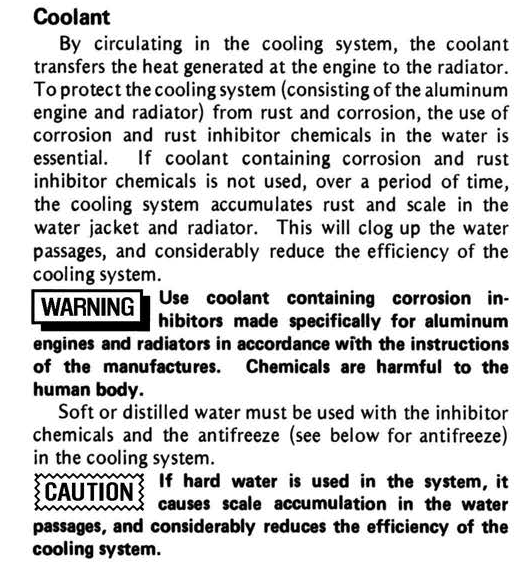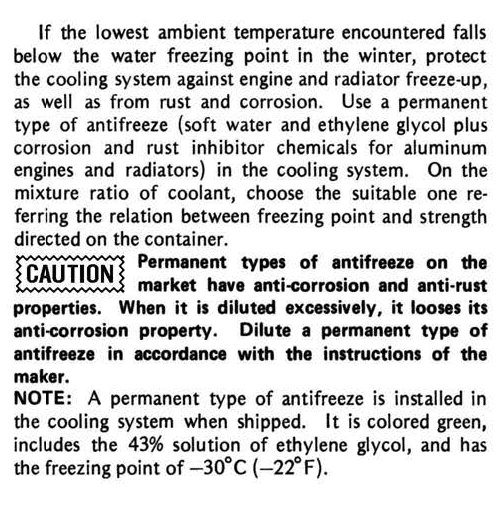Recently, I started a topic called “Cylinder Sleeve Removal / Installation” to provide an instruction for doing the job. Upon removing the cylinder sleeves, I noted that there was significant build up of lime like deposits and under the deposits was significant rusting. Both the scaling and rust build up was easily removed from the surface of the main portion of the sleeve, but I also found minor porosity at the o ring sealing areas of the sleeve.
Picture of a removed sleeve as found
The interior of the cylinder block was found in excellent condition and needed nothing more than a reasonable cleaning especially in the o ring sealing areas primarily due to a build up of some kind of sealing goop that Kawasaki used during the installation of the sleeves into the aluminum block. My concern is based on the scale build up and rusting of the sleeves. Why was the rest of the coolant system in good state of repair and the sleeves showing significant corrosion? I went back to the Factory Service Manual to see if there was a spec on the coolant and found it on page 203 of the manual.


Kawasaki calls for a “coolant containing corrosion inhibitors made specifically for aluminum engines and radiators” and this is where I feel Kawasaki missed the boat. When Kawasaki design built the KZ1300, Z1300 and the ZN1300, they opted to build the cylinder block with a wet sleeve design. To the best of my knowledge, this was the first and only use of the wet sleeves in any of their engines. Most aluminum cylinder blocks with cylinder liners are cast in place liners, meaning that the aluminum block is cast around a cylinder liner and therefore the aluminum bonds to the liner and shields the liner from the coolant in a water cooled engine.
Wet Sleeved engines are typically industrial diesel engines and also larger diesel engines found in semi -trucks. The purpose was to provide better cooling of high horsepower engines and also the ability to rebuild an engine block by replacing the cylinder sleeves and pistons instead of boring out the cylinders and using oversized pistons.
One of the problems with wet sleeves was pitting corrosion on the exterior of the sleeve on the thrust side of the sleeve. Investigations determined that during the combustion process, the sleeve vibrated at a frequency very similar to what happens in an ultrasonic cleaner and the coolant surrounding the sleeve acted like the fluid in an ultrasonic cleaner causing cavitation bubbles to form and collapse on the liner, eroding the surface of the liner. Eventually, pit corrosion would turn into pinholes and migrate through the liner, causing a coolant leak into the cylinder as evidenced by white smoke.
That was the problem that needed to be addressed. There are a couple of ways to address the corrosion issue, one being an anti-corrosion coating on the exterior of the sleeve. Darton Sleeves are a prominent manufacturer of wet sleeves for converting engine blocks with cast in liners to a wet sleeve block primarily for racing engines. Their Modular Integrated Deck (MID) sleeves have a Phosphate coating applied to the exterior of the sleeve to combat corrosion. Darton also recommends using Evans coolant but do not specifically tell you which coolant Evans produces to use. Evans coolant comes in several different types depending on use. There is Evans High Performance Coolant, Evans Heavy Duty Coolant, Evans Powersports Coolant and different versions of their Evans NPG coolants for racing applications.
This leads me to the second way to address the pitting issue and that’s the coolant used. Since the primary use of wet sleeves was in diesel engines ASTM D-6210 or RP-329 by the Technology & Maintenance Council (TMC). This antifreeze is sold with an SCA package already blended in, typically including nitrate to protect iron and steel, tolyltriazole to protect copper and brass, borate or phosphate to buffer acids (formed as glycol breaks down), silicate to protect aluminum and nitrite (sometimes accompanied by molybdate) to form a cavitation-resistant barrier on sleeves.
Kawasaki only required an antifreeze designed for aluminum engines and radiators so they basically forgot to account for the cylinder sleeves which are ductile iron. As noted above, diesel engines with wet sleeves need a nitrate additive to ward off corrosion of the sleeves.
I also sent off an email to Evans asking them which of their coolants to use for engines with wet sleeves to which they replied,
John. Sorry about not seeing your email. HD coolant has an additive for steel parts that contain commercial diesel engines. I don't think that your engine has the same parts. But you can use the HD if you prefer, It is the same coolant as the HP but with more additives for steel parts.
Guy
My interpretation is that Evans HDC coolant was designed for engines containing ductile engine components and is more likely a better choice for the KZ, Z, Zn 1300 engines.
In the last 10 years there has been development of coolants called “Extended Life Coolants” which are a group of coolants designed to accommodate what happens to coolants in engines with wet sleeves. Typically, the additives in wet sleeved engines will plate out on the sleeves to protect the sleeves from corrosion and this depletes the additives in the coolant. Part of the maintenance of diesel engine coolants requires topping up the additives every couple of years to replenish the depleted additives. Another group of long life coolants is the newer Organic Acid Technology antifreezes which use a completely different technology to address corrosion including aluminum, copper, brass, lead and iron, so similar to Evans HDC coolant, would also have additives to accommodate the ductile iron liners of the KZ,Z and ZN engines.
That’s my research findings to date. Hopefully this might change your mind as to which antifreeze to select and why you would want to do this.
KB
This is a pic of my 6 liners. 5 have been cleaned up and 1 was in the state as found when pulled from the cylinder block.
This pic shows the o ring sealing area around the bottom of the sleeve where 2 o rings are meant to seal. Pitting is evident and I am looking for ways to "fix" the pitting. Still doing research on this aspect.
O rings are meant to seal in the 2 areas as marked